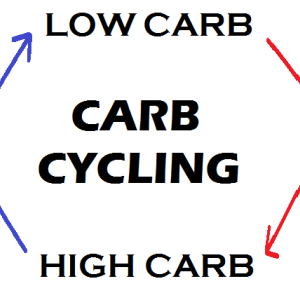CARB CYCLING – IS THERE A REAL BENEFIT?
Carb Cycling Defined
Carb cycling is a diet that cycles your carbohydrate intake (no surprise there) from day to day. For example, you could have 3 different carbohydrate intake days – one low, one medium, and one high. Or, you could have 2 different days – one low and one high and so forth. You would then spread these out across the week depending on your schedule and ideally your weight training routine.
Carb Cycling In Practice
Carb cycling, at least in the way that I like to use it, also involves calorie cycling. That means that your protein and fat intakes are going to be similar day to day and the only variable that will change is the amount of carbohydrates that you are consuming.
Can you lower protein and fat intake on your higher carbohydrate days? Absolutely.
It just requires more attention to detail to your intake and not many beginners would be interested in that and to be quite honest, the benefit may be very minimal, if there is any.
Here are the steps that I like to go through when setting up my own or a client’s carb cycling diet:
Step 1 – Determine the client’s maintenance calorie intake (the number of calories they need to maintain their current weight).
Step 2 – Determine the desired rate of fat loss and create the deficit in terms of weekly calories.
EXAMPLE: A client comes to me with a maintenance intake of 2000 calories or 14000 weekly calories. To lose 1 pound of fat per week (3500 calories), we would need to make sure their intake is at 10500 calories per week or 1500 per week.
Step 3: Assign low, medium, and high carb and calorie days so that the weekly calorie intake matches the rate of fat loss that we want to see (10500 calories).
NOTE: I like to set up the two (usually) higher carb/calorie days right around the client’s maintenance level for reasons that I will discuss in the theory portion of this article. The number of low days are usually determined by how many off/rest days the client has per week. The number of medium days is determined by their training schedule. I always place the two higher days on training days as well.
In our example, this could be the client’s weekly diet:
Monday: 2000 calories
Tuesday: 1500 calories
Wednesday: 1250 calories
Thursday: 2000 calories
Friday: 1250 calories
Saturday: 1250 calories
Sunday: 1250 calories
In this example, the client’s weekly calorie intake still matches what we need to see approximately 1 pound of fat loss per week but the client is able to enjoy both higher and medium carb/calorie days.
But, is there a REAL benefit?
According to research, there might not be much of a difference in a carbohydrate cycling diet vs a regular diet when total calories are controlled. A 3500-calorie deficit is still a 3500-calorie deficit no matter which way you draw it up.
However, there are three notable areas in which a carb / calorie cycling diet may improve.
The first deals with adherence.
We know that all diets work. The only way diets fail is if they are not adhered to. So, adherence, obviously, is a HUGE factor in determining someone’s success.
Which diet would you find more enjoyable?
A diet in which you had to continuously eat lower and lower calories without a break?
OR
A diet in which you had the opportunity to have a little break and eat more calories on certain days of the week?
I would assume that any rational person would choose the latter because it includes days where you do not have to be so restrictive.
The second deals with your metabolism and your body.
It has been said by Lyle McDonald and others’ that your body can recognize that you are in a deficit within 3-5 days – on the lower end of that in women. When your body recognizes this, it will start to down-regulate non-essential bodily functions to preserve energy because it starts to believe that it is starving. Therefore, having a higher carb/calorie day where calories are brought back to maintenance could have an impact and prevent your body from recognizing the deficit that you are in thus never allowing your body to slow down your metabolism in the first place (only if used in the beginning of a dieting phase).
That is why that I recommend that we implement these higher carb/calorie days once every 3-4 days within the diet from the beginning of the diet.
The third deals with your performance in a dieting phase.
As we know, when energy and calories get lower and lower, performance suffers. Your strength decreases in the weight room, your times are reduced in a CrossFit workout, you feel tired, etc. Carb cycling may help improve performance because you are supplying your body with additional carbohydrates on a given day to be used for energy and to refuel muscle glycogen stores.
I recommend using these higher carbohydrate days on tough training days where you can put the additional energy to use.
Summing It All Up
There are numerous ways in which one could set up their own carb cycling diet – you just want to make sure that your weekly deficit is where you need to be to see the fat loss that you desire.
In my opinion, it’s a very useful type of diet if you can manage tracking your carbohydrate intakes on different days as it allows for better adherence, better performance, and may ‘trick” the body into not recognizing a deficit.
